Deciding how to choose a kayak can be an overwhelming experience, especially for those new to the sport. With so many different types, designs, and features available, it’s important to find the right one to suit your specific needs, skill level, and expected use. As a seasoned kayaker, I know a thing or two about selecting the perfect vessel to help you make the most of your time on the water.
The first step in choosing a kayak involves determining the type of kayaking you’ll be primarily participating in. Will you be exploring calm lakes and meandering rivers, or do you plan to tackle more challenging whitewater rapids? Different kayaking disciplines require different kayak designs, so setting your priorities upfront is crucial.
For example, sit-on-top kayaks are perfect for beginners and recreational paddlers, whereas touring kayaks are designed for more experienced adventurers covering longer distances.
Additionally, it’s essential to consider factors such as your budget, the kayak’s weight capacity, and your storage and transportation options. These variables may ultimately impact your decision on which kayak to choose. By focusing on meeting your specific needs and preferences, you’ll be well on your way to finding the perfect kayak and setting off on your adventures with confidence.
Contents
Contents
Understanding Different Kayak Types
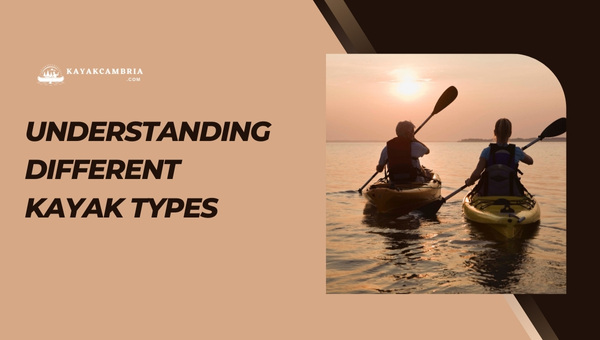
Before diving into how to choose a kayak, it’s crucial to understand the various types available. Knowing the different kayak types will help you make informed decisions based on your specific needs and preferences. Let’s explore some of the common types:
1. Recreational Kayaks
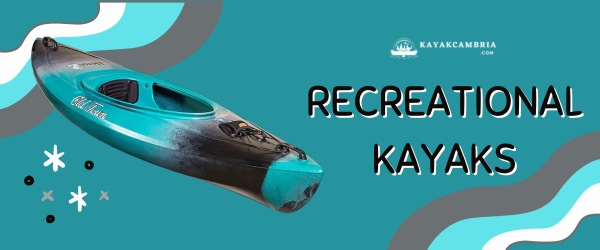
Recreational kayaks are ideal for casual paddlers and beginners. They are typically designed for calm waters, such as lakes and slow rivers. Some key features include:
- Stability: These kayaks provide excellent initial stability, making them easy to maneuver and paddle.
- Spacious: They often have a large, easy-to-enter cockpit and ample room to stretch out and store gear.
- Affordability: Recreational kayaks are generally more affordable than specialized types.
2. Touring Kayaks

Touring kayaks cater to more experienced paddlers seeking adventure on open waters, large lakes, and coastal areas. Notable characteristics include:
- Efficiency: Designed for long-distance paddling, touring kayaks allow for smooth, efficient strokes.
- Storage: These kayaks have ample storage compartments for multi-day trips.
- Longer and Sleeker: Touring kayaks are longer and narrower than recreational kayaks, providing better speed and handling in rougher waters.
3. Whitewater Kayaks

Whitewater kayaks are crafted for adrenaline-packed paddling in swiftly moving waters and rapids. Some main features include:
- Short and Responsive: They have a short length with a high-rocker design, allowing for quick turns and maneuvers.
- Durable: These kayaks are built to withstand impacts from rocks and other obstacles.
- Specialized Designs: Whitewater kayaks come in various subtypes, such as playboats and creek boats, catering to specific skill levels and types of rapids.
4. Fishing Kayaks
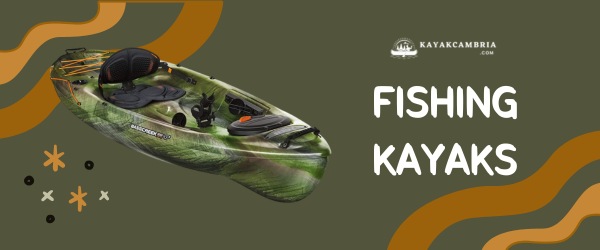
Fishing kayaks are tailored to anglers’ needs, blending the features of recreational and touring kayaks. Some defining attributes are:
- Stability: They offer exceptional stability for casting and reeling in fish.
- Fishing Accessories: Many fishing kayaks come with essential gear, such as rod holders and bait containers.
- Stand-up Capability: Some models allow you to stand up while fishing.
By understanding these different kayak types, you can better gauge which one aligns with your desired paddling environment, style, and budget, making the process of choosing the perfect kayak much simpler.
Determining Your Kayaking Goals
By outlining your purposes, you’ll be better equipped to select a kayak that meets your needs, enhances your paddling experience, and delivers the desired level of comfort and efficiency.
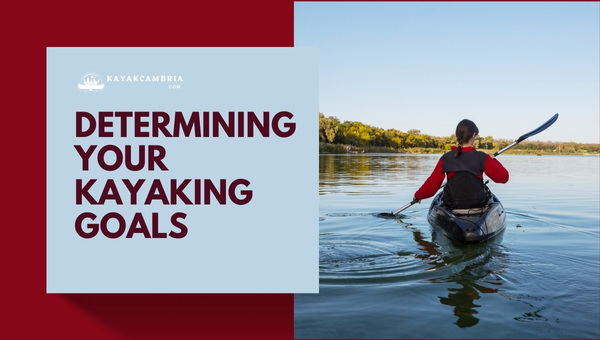
There are several kayaking activities to consider, such as recreational day trips, fishing, overnight camping trips, or adrenaline-pumping whitewater adventures. Let’s take a closer look at these diverse activities to help you narrow down your objectives:
- Recreational Kayaking: If you’re new to kayaking or primarily interested in leisurely paddling on calm waters, choosing a kayak designed for recreational purposes would be ideal. These kayaks typically have a wide, stable hull, are easy to maneuver, and offer ample room to relax.
- Fishing Kayaking: Anglers searching for a vessel from which to cast their lines can find specially designed fishing kayaks. These kayaks typically feature added stability, rod holders, and ample storage space for tackle and gear.
- Touring or Sea Kayaking: If you’re looking to embark on longer journeys, such as coastal exploration or overnight trips, a touring or sea kayak is specifically built for those adventures. These kayaks are longer, narrower, and have a more streamlined shape to improve speed, tracking, and overall efficiency.
- Whitewater Kayaking: For thrill-seekers, whitewater kayaks are designed to tackle rough, turbulent waters, and rapidly changing river conditions. These kayaks are shorter, with a more rounded hull to facilitate quick turns and increased maneuverability.
It’s also worth considering the primary environment in which you’ll be kayaking, as distinct factors can influence your choice of vessel. Consider factors like water temperature, potential hazards, and overall accessibility. For example, colder water climates may require a closed, sit-inside kayak equipped with a neoprene spray skirt to keep your lower body warm and dry.
Ultimately, determining your kayaking goals is an essential first step in understanding how to choose a kayak that best meets your needs. While the options may seem overwhelming at first, taking the time to clarify your objectives will help streamline the selection process and boost your confidence in your final decision.
Considering Kayak Size and Weight
When it comes to how to choose a kayak, one important factor to consider is the size and weight of the kayak. In this section, I’ll discuss the various factors that influence the size and weight of a kayak and how to determine what might be the best fit for you.
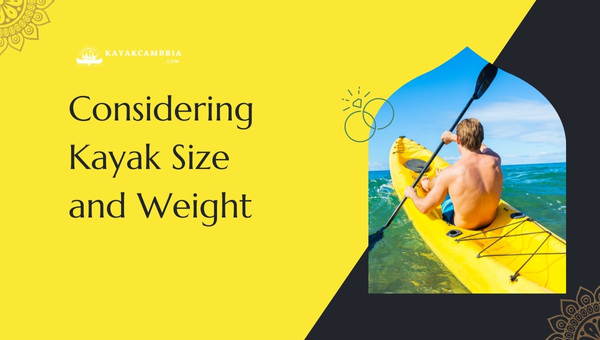
First, let’s look at the length of kayaks. Generally, they can range from 6 to 14 feet (or more), with each length serving a specific purpose:
- Shorter kayaks (6-10 feet): These are great for maneuverability and are ideal for beginners. They’re also perfect for small, calm bodies of water like ponds and creeks.
- Medium-length kayaks (10-12 feet): These offer a balance between stability and maneuverability. They’re suitable for larger lakes and moderate rivers.
- Longer kayaks (12-14 feet and up): These provide better tracking and glide for longer journeys. They’re excellent for ocean kayaking, multi-day trips, and faster-moving rivers.
The width of a kayak, also known as the beam, is another essential factor to consider. Wider beams provide more stability but can sacrifice speed. On the other hand, narrower beams are faster but might be less stable for inexperienced kayakers. Consider the following widths:
- Wide (30 inches or more): High stability, perfect for beginners or fishing.
- Moderate (25-29 inches): Moderate stability and speed, ideal for intermediate kayakers.
- Narrow (less than 25 inches): Fast and agile, best suited for advanced kayakers.
When it comes to weight, lighter kayaks are easier to transport and paddle, but they can also be less durable. Heavier kayaks are usually more rugged but require more effort to paddle and transport. The materials used in kayak construction have a significant impact on their weight. Some common materials include:
- Polyethylene: Affordable, durable, but heavier.
- ABS/acrylonitrile-butadiene-styrene: Slightly lighter than polyethylene, more UV resistant, and moderately priced.
- Composite materials (fiberglass, carbon fiber, Kevlar): Lighter and more rigid, but often more expensive
Lastly, consider the weight capacity of the kayak. Make sure the kayak you choose can support your weight and any gear you plan to bring. Kayak weight capacities can range from 250 to 500 pounds or more.
The Importance of Material Choice
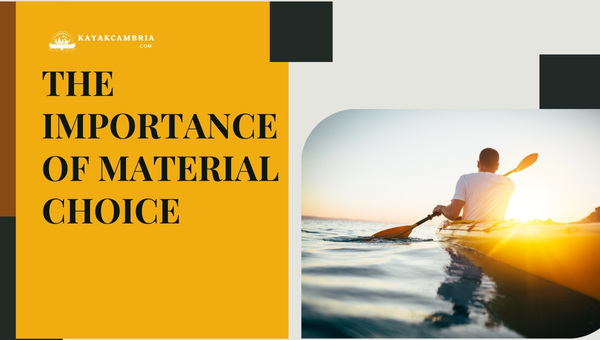
When I’m researching how to choose a kayak, I always emphasize the importance of material choice. Kayaks come in various materials such as polyethylene, ABS plastic, composite, and inflatable materials. Each material offers different advantages and disadvantages, so understanding these factors will help you make the right decision for your kayaking needs.
1. Polyethylene
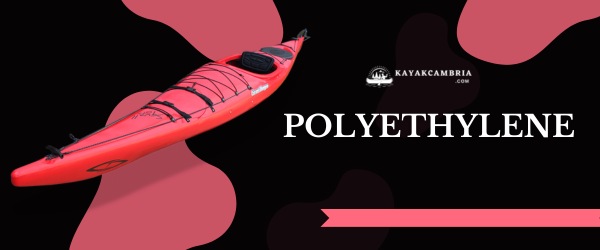
Polyethylene is the most common and affordable material used to make kayaks. Here are the main advantages of polyethylene kayaks:
- Affordable: Polyethylene kayaks are typically less expensive than other materials.
- Durable: This material is quite resistant to impacts, making it an excellent choice for beginners or those who might be rougher with their kayaks.
- Low Maintenance: Little maintenance is required to keep a polyethylene kayak in good condition.
However, polyethylene has some drawbacks, including:
- Heavy: These kayaks tend to be heavier than those made from other materials, which could make transportation more challenging.
- UV Susceptibility: Prolonged exposure to the sun can damage this material, so it’s essential to store your kayak out of direct sunlight.
2. ABS plastic

ABS plastic is another popular material used for kayaks. Some benefits of ABS plastic are:
- Lightweight: ABS plastic is lighter than polyethylene, making it easier to transport.
- UV Resistance: These kayaks are less susceptible to UV damage in comparison to polyethylene kayaks.
A disadvantage for ABS plastic kayaks:
- Price: ABS kayaks are typically more expensive than their polyethylene counterparts.
3. Composite Kayaks
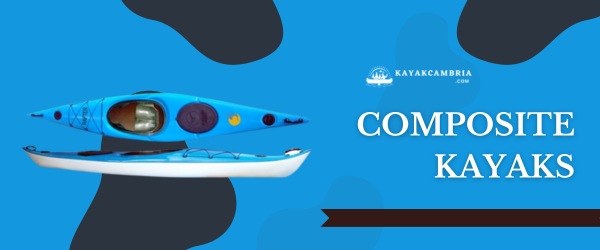
Composite kayaks are made from materials such as fiberglass, carbon fiber, and Kevlar. Some advantages of composite kayaks include:
- Lightweight: They are the lightest material option, making transportation and maneuvering much easier.
- Performance: These kayaks usually offer better performance, such as faster speed and better tracking, than plastic options.
The downsides of composite kayaks are:
- Price: These kayaks are usually the most expensive option.
- Fragile: They can be more prone to damage from impacts, requiring extra care and attention during use and transportation.
4. Inflatable kayaks
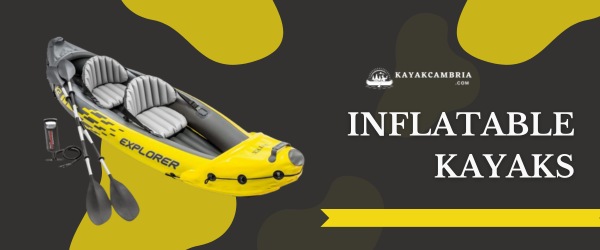
Inflatable kayaks are also an option for those looking for an easy-to-store and transport option. The main benefits of inflatable kayaks are:
- Portability: They can be deflated and easily transported or stored in a small space.
- Affordability: Most inflatable kayaks are more affordable than composite options.
Some disadvantages of inflatable kayaks include:
- Durability: They can be more susceptible to punctures and damage.
- Performance: Typically, inflatable kayaks don’t offer the same performance as rigid kayaks.
So, when learning how to choose a kayak, it’s crucial to consider the material that best suits your needs – it can make a massive difference in your overall kayaking experience. A tip to remember is that selecting the right material affects factors like durability, weight, performance, and price.
Sit-On-Top Vs. Sit-In Kayaks
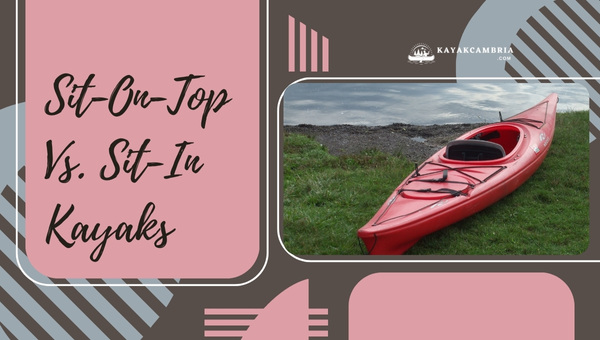
In this section, I’ll dive into the similarities and differences between sit-on-top (SOT) and sit-in (SI) kayaks to help you make an informed choice.
Sit-on-top kayaks are popular for their user-friendly design and are ideal for beginners and casual paddlers. Here are some notable characteristics of sit-on-top kayaks:
- Open, stable platform
- Self-draining scupper holes
- Great for warm-weather paddling
- Easy to get on and off
SOT kayaks are perfect for recreational paddling, fishing, or even snorkeling since you can easily slide off the kayak and swim around without worrying about filling your kayak with water. However, one downside to sit-on-top kayaks is that they’re less suited for rough waters and cooler temperatures, as you’ll be more exposed to the elements.
On the other hand, sit-in kayaks are designed with a cockpit that you sit inside, providing you with more protection from water and wind. Here are some highlights of sit-in kayaks:
- More efficient hull designs
- Enhanced control, especially with thigh braces or knee pads
- Storage compartments for gear
- Better suited for cold-weather paddling
Sit-in kayaks are ideal for longer trips, rougher water conditions, and those who seek better control and speed. With practice, you can even learn to perform advanced kayaking maneuvers, like rolling the kayak when capsized. The main downside to sit-in kayaks is that they can be more difficult to enter and exit, especially in case of a capsize.
To decide between SOT and SI kayaks, consider the following factors:
- Skill level: Beginners typically find SOT kayaks more comfortable, while experienced paddlers often prefer the control of SI kayaks.
- Environment: If you live in a warmer climate and plan casual outings, SOT kayaks may be more practical. For colder climates or more varied water conditions, SI kayaks can offer more versatility.
- Intended use: If you’re into fishing or snorkeling, SOT kayaks offer a more convenient platform. For touring or dealing with harsher conditions, SI kayaks can provide better performance.
Evaluating Seats and Storage
When I’m figuring out how to choose a kayak, one of the key factors I consider is the comfort and convenience provided by the kayak’s seats and storage. To ensure the best experience during your paddle adventures, it’s important to pay close attention to these features.
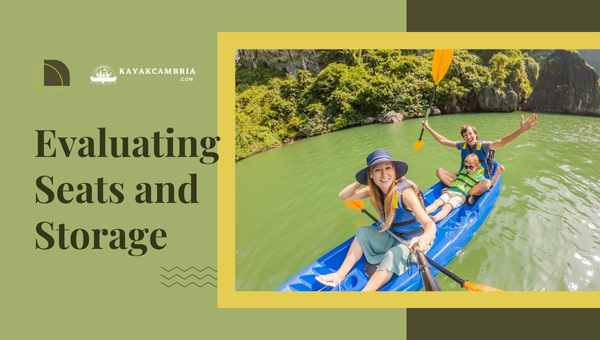
A comfortable seat can make all the difference in your kayaking experience. Look for seats with:
- Adequate padding
- Adjustable backrests
- Good lumbar support
- Ventilation to prevent overheating
Some kayaks offer upgraded seating options, so don’t hesitate to explore those if comfort is a priority.
Storage is another crucial aspect to evaluate when choosing a kayak. Depending on the type of kayaking I plan to do, I’ll need varying amounts of storage. For instance, casual day trips may require less storage, while long expeditions demand more space to store camping equipment, food, and other essentials. Here are some storage options I consider:
- Hatches: These are built-in compartments in the hull of the kayak. They provide watertight storage and protect your gear from water damage.
- Bungee cords: Commonly found on top of the kayak, these cords securely hold items within easy reach during your trip. They’re great for keeping water bottles, maps, or other items you want to access quickly.
- Deck rigging: This comprises elastic cords or lines on the deck, allowing you to attach or store gear externally.
- Bulkheads: These are internal walls that separate the kayak into different watertight compartments, providing additional storage (commonly found in sea kayaks).
As you search for the perfect kayak, keep in mind that some storage options might not be available on all models. However, knowing your specific needs in terms of seating and storage will help you make an informed decision on how to choose a kayak tailored to your requirements.
Paddles and Accessories to Consider
A great paddling experience is determined not only by the kayak itself but also by the additional equipment you use. In this section, I’ll break down the key factors to consider when picking out paddles and other essential accessories.
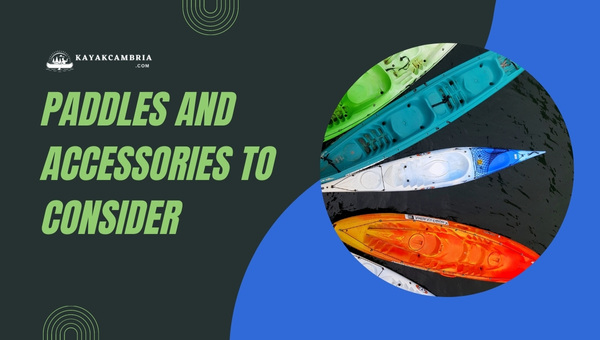
Paddles play a crucial role in the overall kayaking experience. They come in various materials, lengths, and blade shapes. When choosing a paddle, you should take into account the following factors:
- Material: Paddle materials include plastic, aluminum, fiberglass, and carbon fiber. Each has its pros and cons in terms of weight, durability, and cost. Generally, lighter materials like carbon fiber make for more comfortable paddling but come at a higher price.
- Length: The ideal paddle length depends on your height, the width of your kayak, and your paddling style. A good rule of thumb is to choose a paddle that’s taller than your standing height. Longer paddles are well-suited for wider kayaks, while shorter paddles are better for narrower kayaks.
- Blade shape: There are two main blade shapes – high-angle and low-angle. High-angle blades are shorter and wider, designed for aggressive paddling and quicker acceleration. Low-angle blades are longer and narrower, making them ideal for a relaxed paddling style and energy conservation.
In addition to paddles, it’s essential to consider other accessories that can enhance your kayaking experience:
- Life jackets (PFDs): Personal Flotation Devices (PFDs) are an absolute must for safety. Choose a life jacket that is US Coast Guard-approved, fits comfortably, and is designed specifically for paddling.
- Spray skirts: For those looking to kayak in rougher waters or colder conditions, a spray skirt can help keep water out of the cockpit, providing warmth and a dryer ride.
- Bilge pumps: These handy tools can quickly remove water from the cockpit, ensuring a safer and drier kayaking experience.
- Dry bags: Water-resistant bags that protect your belongings from getting wet while kayaking.
- Seats/Seat Pads: Adding a comfortable seat or seat pad can significantly improve your paddling experience, especially on longer trips.
- Paddle leashes: A simple yet effective accessory that secures your paddle to your kayak, preventing it from drifting away.
As you learn how to choose a kayak, don’t forget to factor in your paddle and accessory choices. This combination ensures that your time on the water is not only fun and exciting but safe and comfortable as well.
New Versus Used Kayaks
When you’re figuring out how to choose a kayak, one of the first decisions you’ll face is whether to buy a new or used one. I’m here to guide you through the pros and cons of each option in order to help you find the perfect fit.
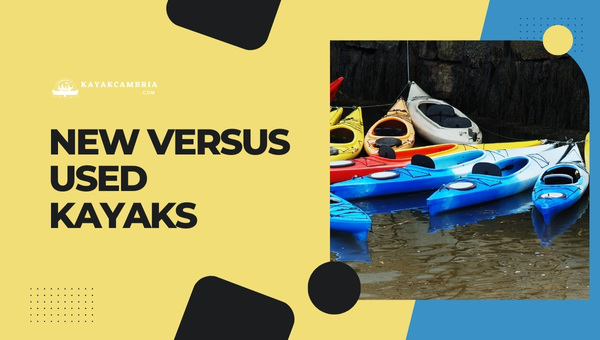
New kayaks offer a range of benefits:
- Factory warranty: Most new kayaks come with a warranty, giving you peace of mind and protection against manufacturing defects.
- Customization options: When buying a new kayak, you can often choose the color, materials, and features you prefer.
- Latest technology: Newer kayaks may incorporate advanced designs and features, which can enhance your paddling experience and make your time on the water more comfortable.
- No wear and tear: A new kayak will be in pristine condition, with no signs of use or damage.
However, new kayaks also have their drawbacks:
- Price: Generally, new kayaks are more expensive than used ones, which may be a factor if you’re working with a budget.
- Depreciation: Like other consumer goods, once you take your new kayak home, it’s value will begin to depreciate.
On the flip side, there are some advantages of used kayaks:
- Lower price: You’ll typically find better deals on used kayaks, allowing you to stretch your budget and possibly acquire a higher-quality model than if you bought new ones.
- More options: When shopping for a used kayak, you’ll often encounter a wider variety of models and styles no longer in production.
- Less depreciation: A used kayak won’t suffer as dramatic a drop in value after purchase, so if you decide to sell or upgrade later on, your investment may be more secure.
With used kayaks, though, come a few potential cons:
- Possible damage: It’s crucial to inspect a used kayak thoroughly for signs of wear, previous repairs, or damage that could affect its performance or safety.
- No warranty: Most used kayaks won’t have a warranty, which means you may be on the hook for any necessary repairs or replacements.
- Limited customization: When buying a used kayak, you may have to compromise on certain features, colors, or materials.
Ultimately, the decision between a new or used kayak will depend on your individual needs, budget, and preferences. By considering the pros and cons, you’ll be one step closer to finding the perfect kayak to hit the water with confidence.
In Conclusion: Making Your Final Decision
I’ve covered the essential factors to consider when contemplating how to choose a kayak. It’s now time for you to make a decision based on the information provided. Weigh the pros and cons of various kayak types, keeping your needs and preferences in mind.
Some key factors you should consider include:
- Your purpose for kayaking (recreational, touring, whitewater, or fishing)
- Your skill level
- The type of water you’ll be paddling in (calm, ocean, or rapids)
- Your budget
- Storage and transportation options
You should also ensure the kayak is a comfortable fit:
- Appropriate cockpit size for easy entry and exit
- Adequate legroom for a comfortable paddling experience
- Adjustable footrests
- Comfortable seating
Don’t forget to try before you buy. It’s important to invest time in testing different kayak models until you find the one that fits your needs and feels just right. You can do this by visiting a local dealer, attending a demo day, or renting different types of kayaks.
Lastly, remember that safety comes first. Invest in good-quality paddling gear, such as a personal flotation device (PFD), a whistle, a bilge pump, and other necessary safety equipment.
By thoroughly understanding the various factors involved in selecting the perfect kayak, you are now well-equipped to make a confident decision. Whatever choice you make, I’m sure it’ll lead to countless memorable paddling adventures. Happy kayaking!

